Motion-Induced Noise Detection of Electrode-Pair Towed Antennas Using Helix Coil Sensors
Abstract
:1. Introduction
- A new helix coil sensors structure with conformal towed antenna was proposed to simultaneously detect the motion-induced noise of an electrode-pair towed antenna. The RLCG transmission line model was established. The influence of the inner shielding layer on the mutual inductance of the helix coil was analyzed based on the mirror principle, and the potential equation of the antenna was derived.
- The water flow cycling experimental platform was constructed. Two type of towed antenna sections were designed and testified. The results showed that the helix coil sensors detected motion-induced noise synchronized with the electrode-pair towed antenna, and achieved higher correlation with vibrations than accelerators.
2. Proposed Methods
2.1. A. Sensor Structure
2.2. Principle of Motion-Induced Noise Detection
2.3. Equivalent Circuit
3. Experimental Results
3.1. Experimental Platform
3.2. Results Analysis
3.3. Comparisons of Helix Coil Sensors and Accelerators
4. Discussions
5. Conclusions
Author Contributions
Funding
Acknowledgments
Conflicts of Interest
References
- Lin, S.-C.; Alshehri, A.A.; Wang, P.; Akyildiz, I.F. Magnetic Induction-Based Localization in Randomly Deployed Wireless Underground Sensor Networks. IEEE Internet Things J. 2017, 4, 1454–1465. [Google Scholar] [CrossRef]
- Ren, L.; Yu, K.; Tan, Y. A Self-Powered Magnetostrictive Sensor for Long-Term Earthquake Monitoring. IEEE Trans. Magn. 2020, 56, 2958783. [Google Scholar] [CrossRef]
- Rivera, D.; Bansal, R. Towed antennas for US submarine communications: A historical perspective. IEEE Antennas Propag. Mag. 2004, 46, 23–36. [Google Scholar] [CrossRef]
- Huang, Z.; Jiang, Y. Motion-Induced Noise Modeling of Towed Magnetic Antenna. IEEE Trans. Antennas Propag. 2022, 70, 6433–6443. [Google Scholar] [CrossRef]
- Burrows, M. Motion-Induced Noise in Electrode-Pair Extremely Low Frequency (ELF) Receiving Antennas. IEEE Trans. Commun. 1974, 22, 540–542. [Google Scholar] [CrossRef]
- Dowling, A.P. The dynamics of towed flexible cylinders Part 1. Neutrally buoyant elements. J. Fluid Mech. 1988, 187, 507–532. [Google Scholar] [CrossRef]
- Maksimenko, V.G.; Naryshkin, V.I. Motion noise of the electrode-type electric field sensors moving in seawater and means of its reduction. J. Commun. Technol. Electron. 2003, 48, 62–67. [Google Scholar]
- Maksimenko, V.G. Noise of Electrode Sensor in Pulsating Liquid Flow. J. Commun. Technol. Electron. 2017, 62, 1086–1093. [Google Scholar] [CrossRef]
- Djanni, A.T.; Ziolkowski, A.; Wright, D. Electromagnetic induction noise in a towed electromagnetic streamer. Geophysics 2016, 81, E187–E199. [Google Scholar] [CrossRef] [Green Version]
- Ronaess, M.; Lindqvist, U.P. Method and Apparatus for Reducing Induction Noise in Measurements Made with a Towed Electromagnetic Survey System. U.S. Patent 7 671 598B2, 2 March 2010. [Google Scholar]
- Ziolkowski, A.M.; Carson, R.G. Method for Reducing Induction Noise in Towed Marine Electromagnetic Survey Signals. U.S. Patent 8 649 992B2, 11 February 2014. [Google Scholar]
- Chen, K.; Zhao, Q.; Deng, M.; Luo, X.; Jing, J. Seawater motion-induced electromagnetic noise reduction in marine magnetotellu-ric data using current meters. Earth Planets Space 2020, 72, 1–11. [Google Scholar] [CrossRef] [Green Version]
- Fiorillo, A.; Critello, C.; Pullano, S. Theory, technology and applications of piezoresistive sensors: A review. Sens. Actuators A Phys. 2018, 281, 156–175. [Google Scholar] [CrossRef]
- Lin, F.; Zheng, H.; Xiang, B.; Xu, R.; Jiang, W.; Lang, L. Vibration-Induced Noise in Extremely Low Frequency Magnetic Receiving Antennas. IEEE Antennas Wirel. Propag. Lett. 2021, 20, 913–917. [Google Scholar] [CrossRef]
- Maksimenko, V.G. Noise of an Electrode Sensor in a Flow of Liquid. J. Commun. Technol. Electron. 2017, 62, 1238–1244. [Google Scholar] [CrossRef]
- Burrows, M.L. On the Design on a Towed ELF H-Field Antenna. MIT Lincoln Laboratory, Lexington, Mass., Tech. Note 1972-34 (DDC AD-754949). 1972. Available online: https://www.semanticscholar.org/paper/On-the-Design-on-a-Towed-ELF-H-Field-Antenna-Burrows/342c7b55a6c3256b971e7c1ca96da2245789ecc7 (accessed on 1 December 2022).
- Mei, S.T.; Weng, C.C. Electromagnetics, Physics, and Mathematics; John Wiley & Sons, Ltd.: New York, NY, USA, 2020. [Google Scholar]
- Rao, G.S. Electromagnetic Field Theory and Transmission Lines; Wiley India: New Delhi, India, 2013. [Google Scholar]
- Maksimenko, V.G. Motion Noise of an Electrode Sensor and Its Relationship with Fluid Velocity Fluctuations. J. Commun. Technol. Electron. 2020, 65, 1167–1172. [Google Scholar] [CrossRef]
- Djanni, A.T.; Ziolkowski, A.; Wright, D. Estimation of Induction Noise in a Towed EM Streamer. In Proceedings of the 76th EAGE Conference and Exhibition 2014, Amsterdam, The Netherlands, 16–19 June 2014. [Google Scholar] [CrossRef]
- Kheiri, M.; Païdoussis, M.P.; Amabili, M. A nonlinear model for a towed flexible cylinder. J. Sound Vib. 2013, 332, 1789–1806. [Google Scholar] [CrossRef]

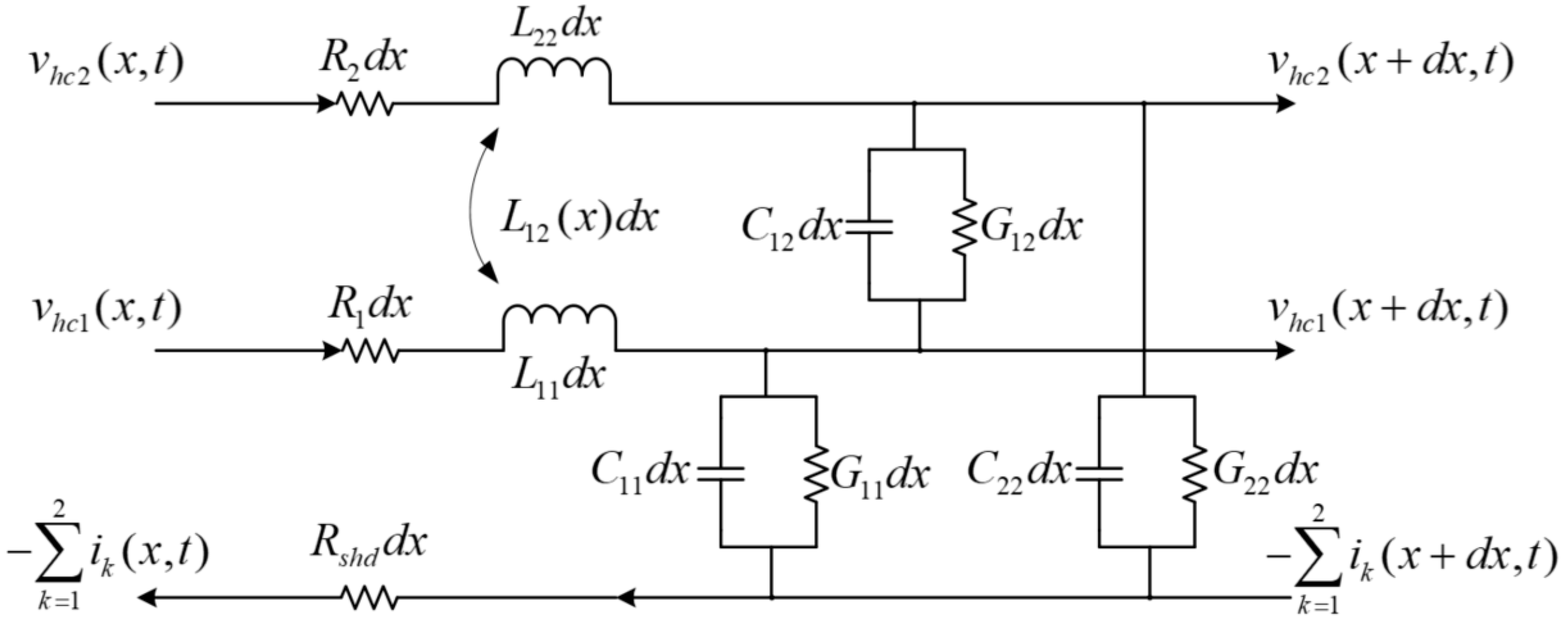


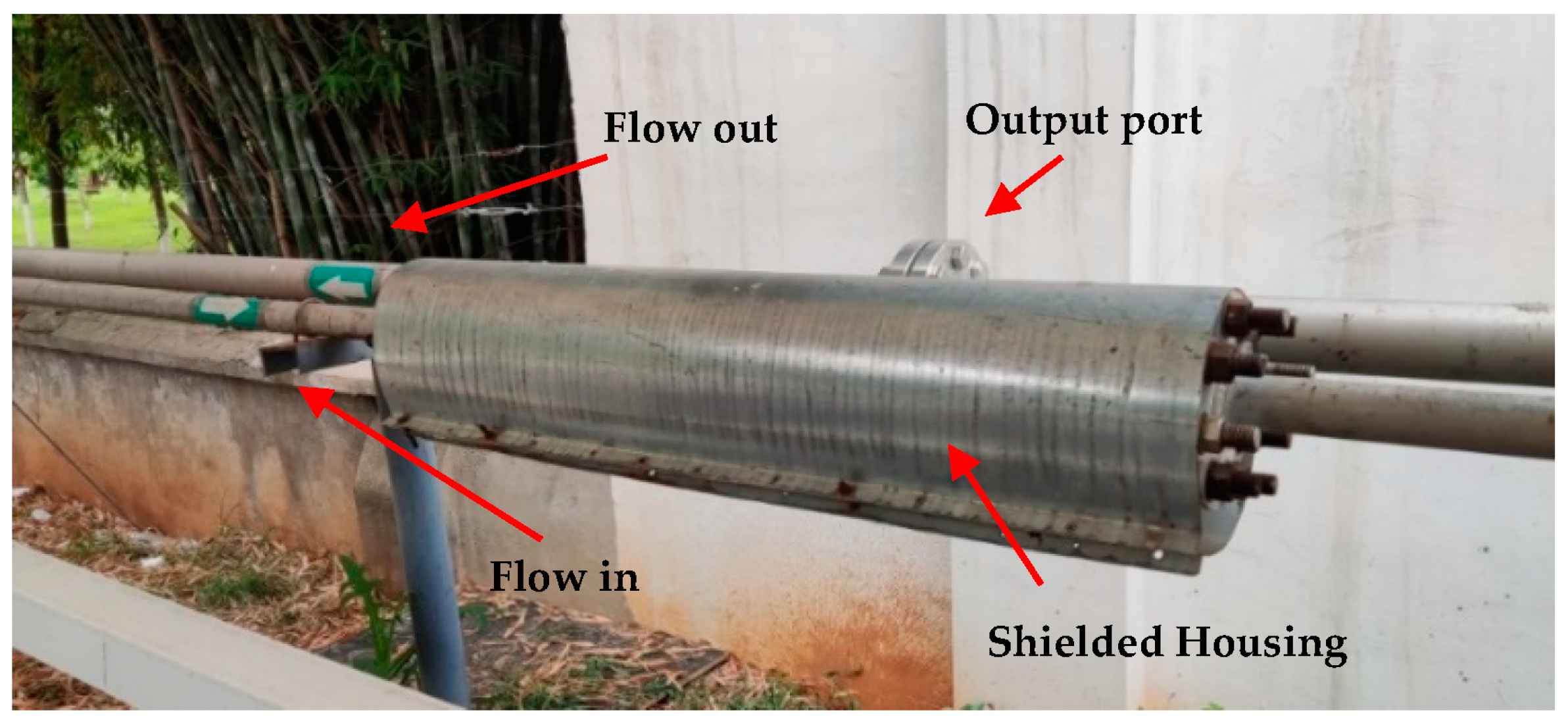
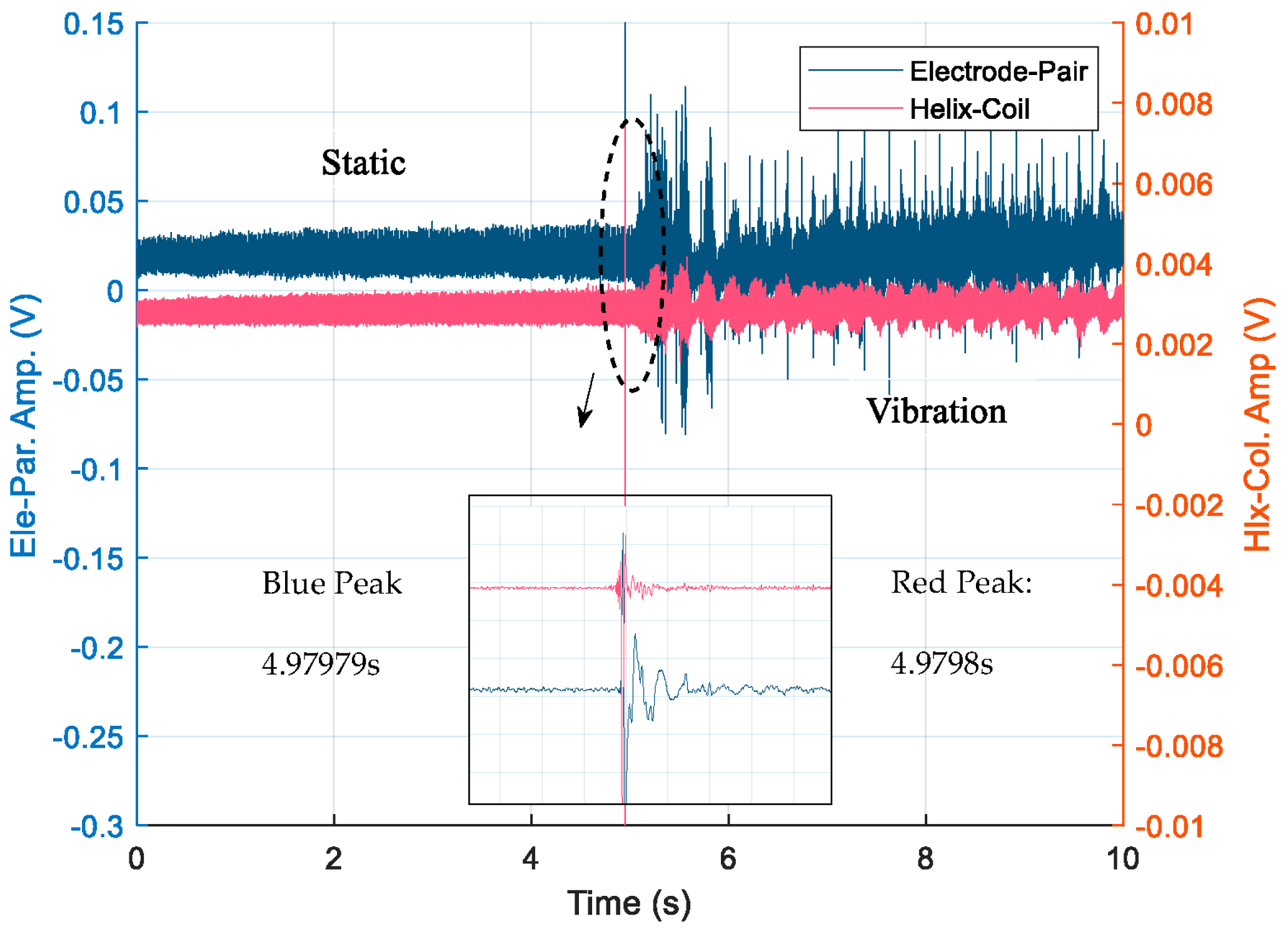
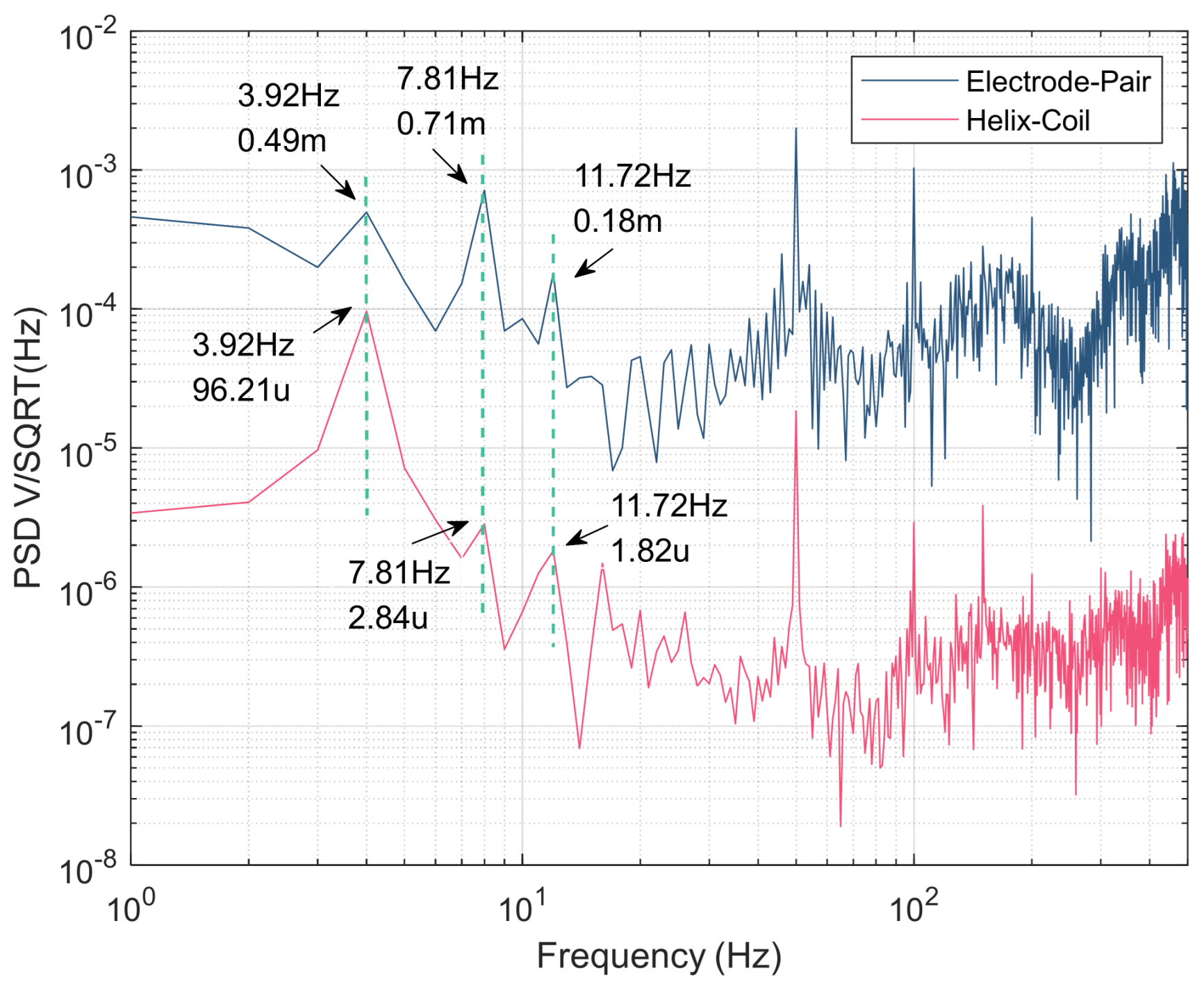

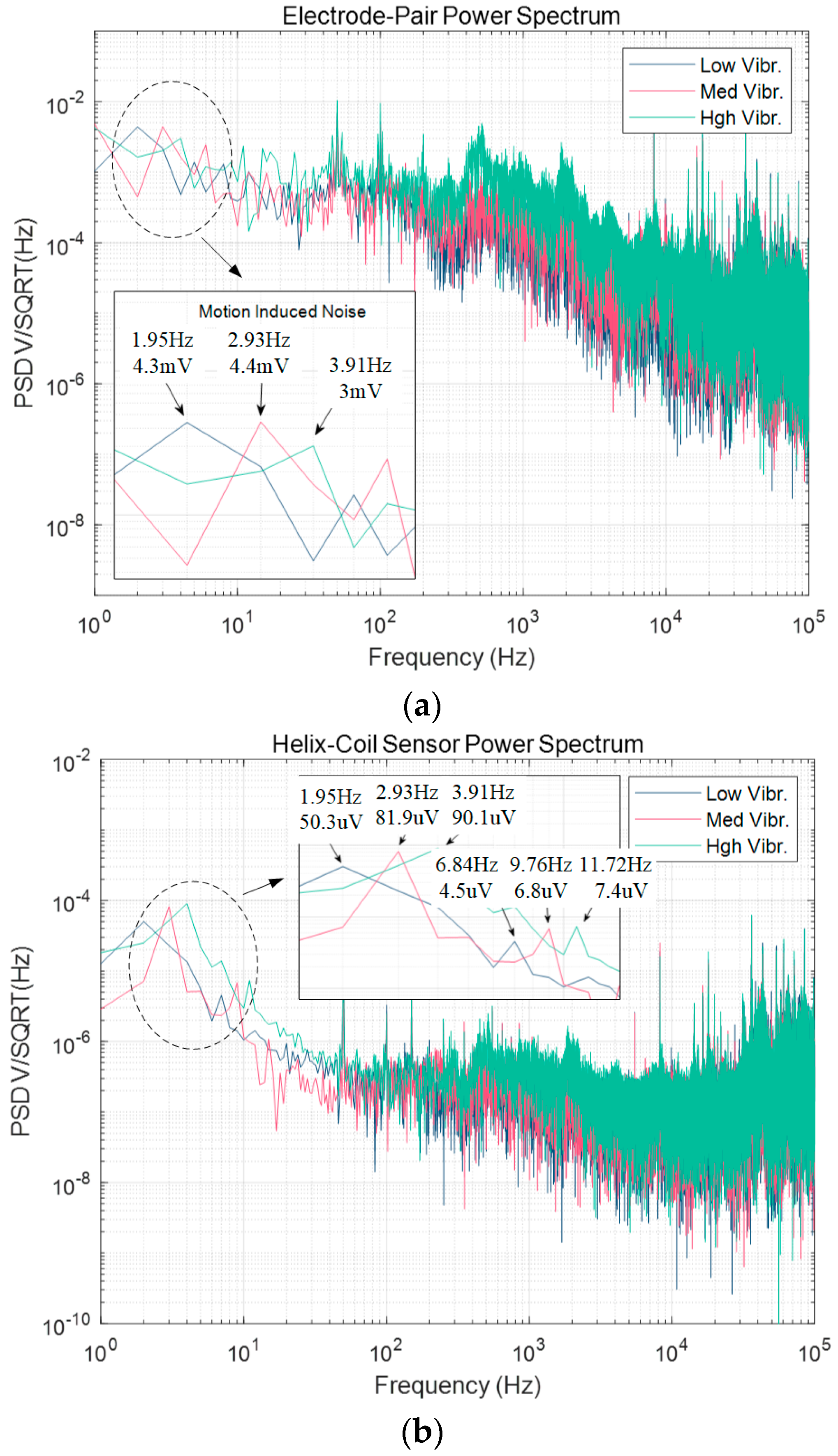

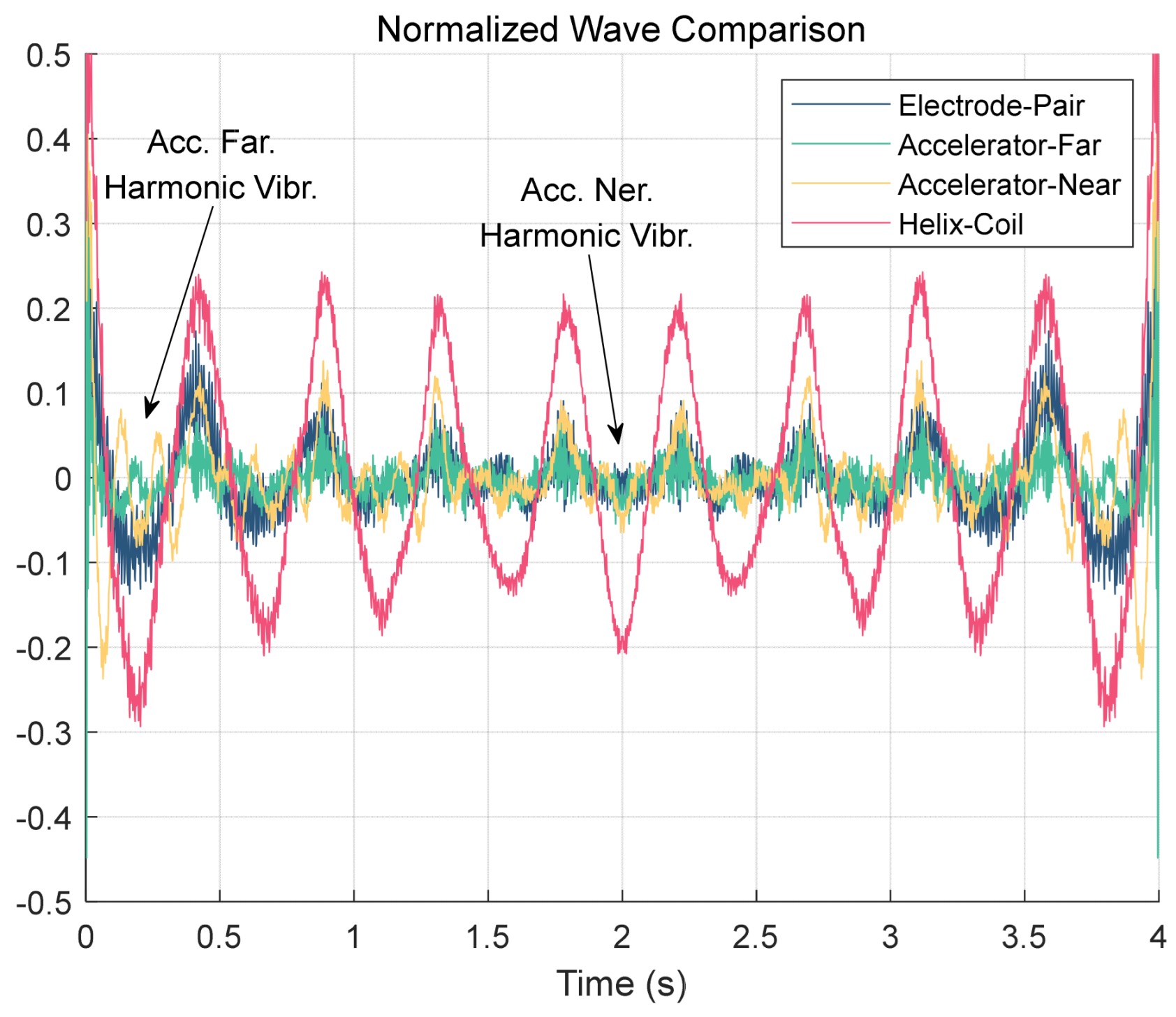

| Components | Parameters | Value |
|---|---|---|
| Helix coil sensors | material | Copper |
| wire diameter | 0.5 mm | |
| winding diameter | 17.8 mm | |
| pitch | 11.5 mm | |
| coil turns | 80 | |
| Electrode-pair towed antenna | material | Stainless steel |
| electrode diameter | 18.5 mm | |
| electrode length | 60 mm | |
| distance | 1 m | |
| cable jacket | Polyethylene |
| Antenna State | Time Domain (mV) | PSD (uV/Hz−1/2) | ||
|---|---|---|---|---|
| Ele-Par. Vpp | Hlx-Col. Vpp | Ele-Par. Vpp | Hlx-Col. Vpp | |
| Static | 48.38 | 0.81 | 220.21 | 1.43 |
| Low Vibr. | 241.24 | 2.97 | 738.45 | 4.28 |
| Med Vibr. | 460.41 | 3.27 | 992.19 | 6.02 |
| Hgh Vibr. | 814.91 | 3.53 | 1635.36 | 8.39 |
| Antenna State | re-h | re-f | re-n |
|---|---|---|---|
| Low Vibr. | 0.88 | 0.71 | 0.48 |
| 0.78 | 0.68 | 0.51 | |
| Med Vibr. | 0.94 | 0.83 | 0.66 |
| 0.84 | 0.91 | 0.71 | |
| Hgh Vibr. | 0.81 | 0.92 | 0.77 |
| 0.69 | 0.95 | 0.78 |
Disclaimer/Publisher’s Note: The statements, opinions and data contained in all publications are solely those of the individual author(s) and contributor(s) and not of MDPI and/or the editor(s). MDPI and/or the editor(s) disclaim responsibility for any injury to people or property resulting from any ideas, methods, instructions or products referred to in the content. |
© 2023 by the authors. Licensee MDPI, Basel, Switzerland. This article is an open access article distributed under the terms and conditions of the Creative Commons Attribution (CC BY) license (https://creativecommons.org/licenses/by/4.0/).
Share and Cite
Xie, X.; Zuo, H.; Wei, S.; Wu, Q. Motion-Induced Noise Detection of Electrode-Pair Towed Antennas Using Helix Coil Sensors. Electronics 2023, 12, 1677. https://doi.org/10.3390/electronics12071677
Xie X, Zuo H, Wei S, Wu Q. Motion-Induced Noise Detection of Electrode-Pair Towed Antennas Using Helix Coil Sensors. Electronics. 2023; 12(7):1677. https://doi.org/10.3390/electronics12071677
Chicago/Turabian StyleXie, Xu, Hao Zuo, Shize Wei, and Qin Wu. 2023. "Motion-Induced Noise Detection of Electrode-Pair Towed Antennas Using Helix Coil Sensors" Electronics 12, no. 7: 1677. https://doi.org/10.3390/electronics12071677






